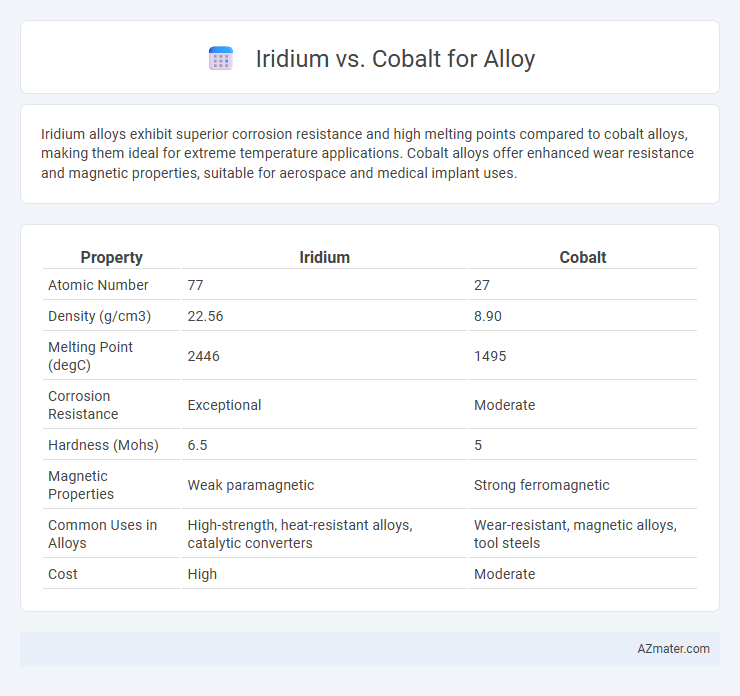Iridium alloys exhibit superior corrosion resistance and high melting points compared to cobalt alloys, making them ideal for extreme temperature applications. Cobalt alloys offer enhanced wear resistance and magnetic properties, suitable for aerospace and medical implant uses.
Table of Comparison
| Property | Iridium | Cobalt |
|---|---|---|
| Atomic Number | 77 | 27 |
| Density (g/cm3) | 22.56 | 8.90 |
| Melting Point (degC) | 2446 | 1495 |
| Corrosion Resistance | Exceptional | Moderate |
| Hardness (Mohs) | 6.5 | 5 |
| Magnetic Properties | Weak paramagnetic | Strong ferromagnetic |
| Common Uses in Alloys | High-strength, heat-resistant alloys, catalytic converters | Wear-resistant, magnetic alloys, tool steels |
| Cost | High | Moderate |
Introduction to Iridium and Cobalt Alloys
Iridium and cobalt are essential elements in high-performance alloys, prized for distinct properties in industrial applications. Iridium alloys exhibit exceptional corrosion resistance and high-temperature stability, making them ideal for aerospace and electronics. Cobalt alloys offer superior strength, wear resistance, and magnetic properties, widely used in medical implants, turbine blades, and cutting tools.
Chemical and Physical Properties Comparison
Iridium exhibits exceptional corrosion resistance and a melting point of 2446degC, making it one of the densest and most durable metals, ideal for high-temperature applications in alloys. Cobalt, with a melting point of 1495degC, offers excellent magnetic properties and moderate corrosion resistance, enhancing toughness and wear resistance in alloys. The significant difference in density--iridium at 22.56 g/cm3 and cobalt at 8.90 g/cm3--affects the weight and mechanical strength of the final alloy, guiding material selection based on performance requirements.
Strength and Durability Factors
Iridium alloys exhibit exceptional strength and high corrosion resistance, making them ideal for applications requiring extreme durability under harsh conditions. Cobalt alloys offer superior wear resistance and maintain structural integrity at elevated temperatures, often used in aerospace and medical implants. Compared to cobalt, iridium's higher melting point and density contribute to increased hardness and prolonged lifespan in alloy compositions.
Corrosion and Oxidation Resistance
Iridium exhibits superior corrosion and oxidation resistance compared to cobalt, making it highly valuable for applications requiring durability in extreme environments. Its high melting point and stable oxide layer protect alloys from degradation even at elevated temperatures. While cobalt provides good resistance, iridium alloys maintain integrity longer under oxidative stress, enhancing lifespan in aerospace and chemical processing industries.
Thermal and Electrical Conductivity
Iridium exhibits superior thermal conductivity at approximately 147 W/m*K compared to cobalt's 100 W/m*K, making it more efficient for high-temperature applications. In terms of electrical conductivity, cobalt offers around 17.0 MS/m, outperforming iridium's lower conductivity near 7.0 MS/m, which influences their use in electrical components. The choice between iridium and cobalt alloys depends on the balance required between thermal management and electrical performance in specific industrial applications.
Industrial and Technological Applications
Iridium and cobalt alloys are crucial in high-performance industrial and technological applications due to their exceptional hardness, corrosion resistance, and thermal stability. Iridium alloys excel in aerospace and electronics for components exposed to extreme temperatures and chemical environments, while cobalt alloys are preferred in manufacturing cutting tools, turbines, and magnetic devices for their superior wear resistance and magnetic properties. The choice between iridium and cobalt alloys hinges on specific application requirements such as temperature tolerance, mechanical strength, and resistance to oxidation.
Cost and Availability Analysis
Iridium alloys are significantly more expensive due to iridium's rarity and limited global supply, with prices often exceeding cobalt by a substantial margin. Cobalt is more abundant and widely mined, primarily in the Democratic Republic of Congo, making it a more cost-effective choice for large-scale alloy production. The availability of cobalt supports consistent manufacturing, whereas iridium's scarcity restricts its use to specialized high-performance applications despite its superior corrosion resistance.
Environmental Impact and Sustainability
Iridium and cobalt are both valuable for high-strength alloys, but their environmental impacts differ significantly. Iridium, largely sourced as a byproduct of platinum mining, has a smaller ecological footprint compared to cobalt, which often involves environmentally damaging mining practices and ethical concerns related to labor in the Democratic Republic of Congo. Sustainable alloy production increasingly favors iridium due to its more stable supply chain and lower associated environmental degradation compared to cobalt's intensive extraction process.
Performance in Extreme Conditions
Iridium offers exceptional corrosion resistance and maintains structural integrity at temperatures exceeding 2200degC, making it ideal for extreme high-temperature environments, while cobalt alloys excel in strength, creep resistance, and thermal stability under prolonged stress up to 900degC. Cobalt's magnetic properties and fatigue resistance provide superior performance in cyclic loading and harsh mechanical conditions. Selecting between iridium and cobalt alloys depends on the specific temperature range, environmental exposure, and mechanical demands of the application.
Choosing the Right Alloy for Your Needs
Iridium offers exceptional corrosion resistance and high melting points, making it ideal for applications requiring durability in extreme conditions. Cobalt alloys excel in strength and wear resistance, often preferred for medical implants and aerospace components due to their toughness and biocompatibility. Select iridium for chemical stability and extreme temperature endurance, while cobalt suits mechanical strength and impact resistance demands.

Infographic: Iridium vs Cobalt for Alloy
 azmater.com
azmater.com